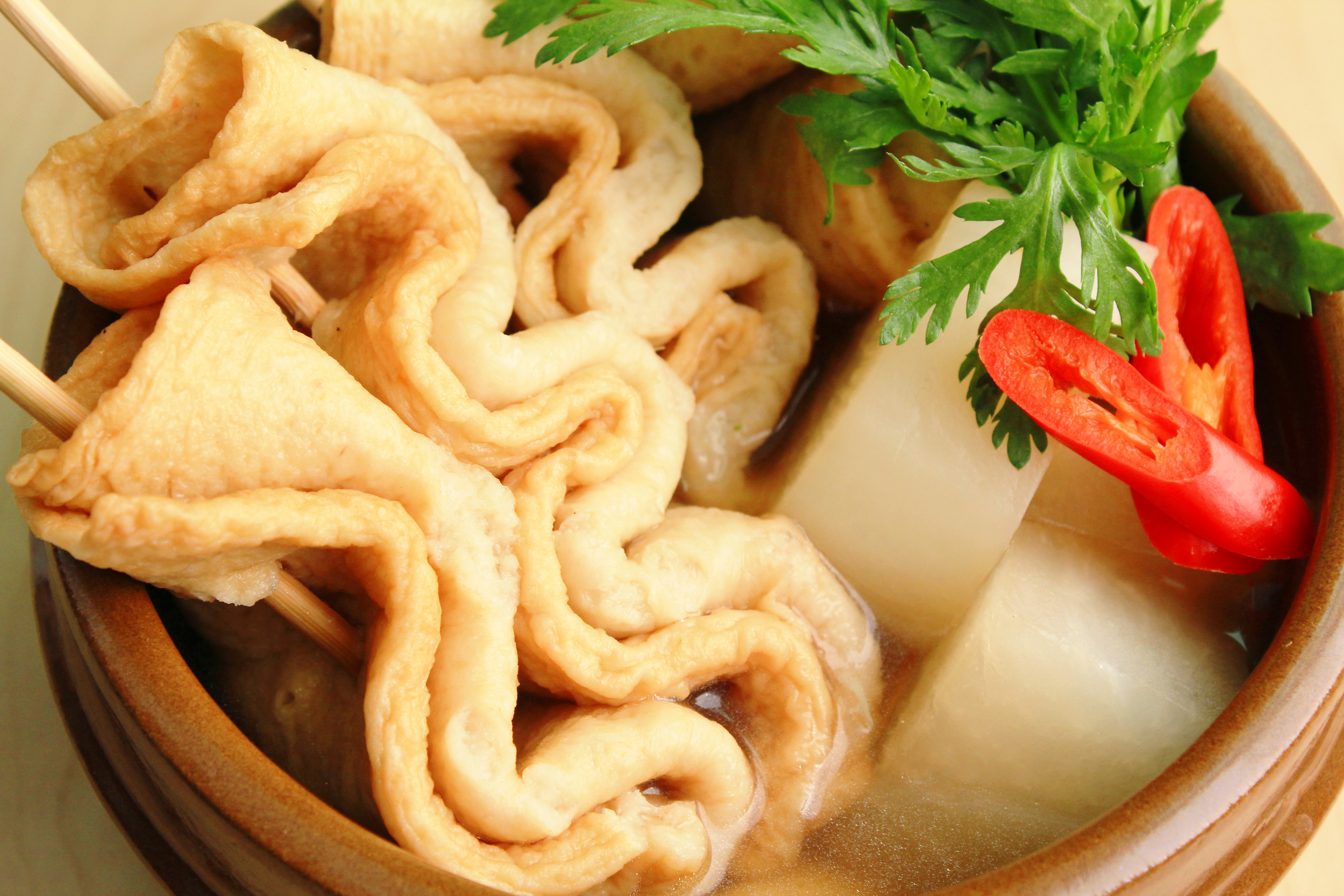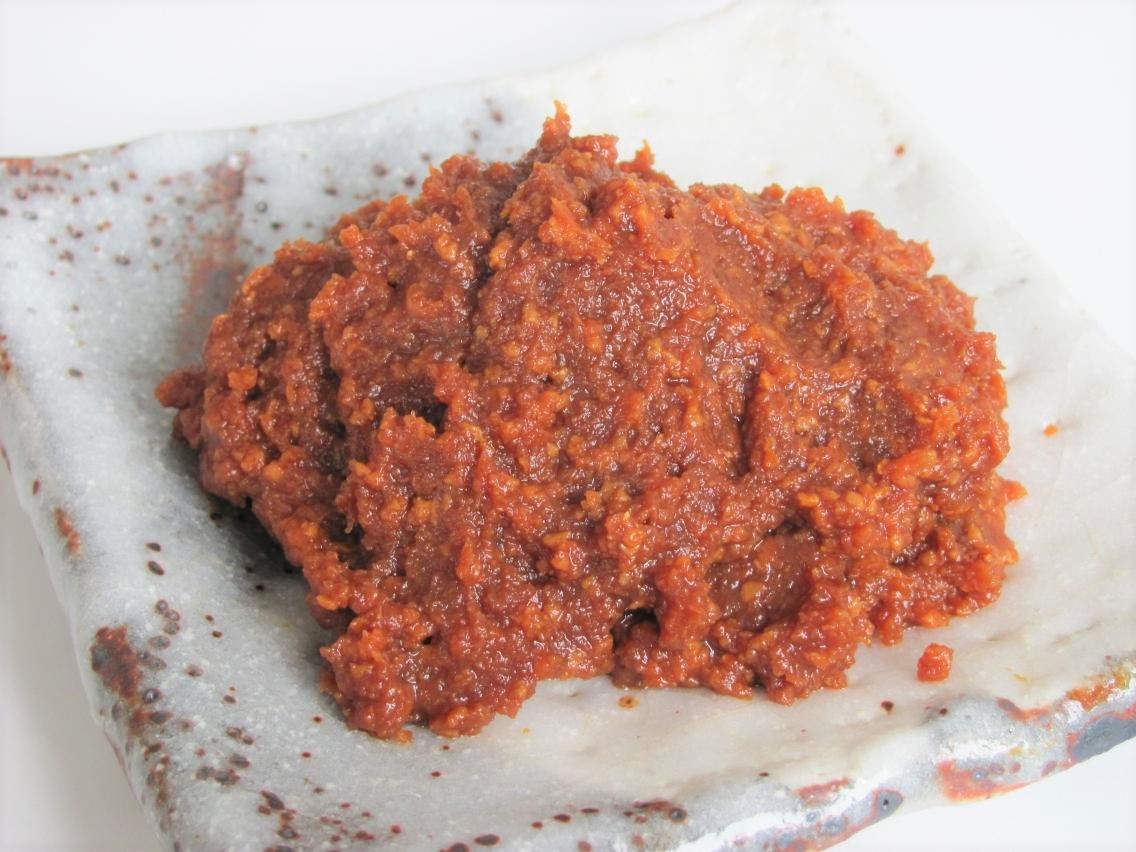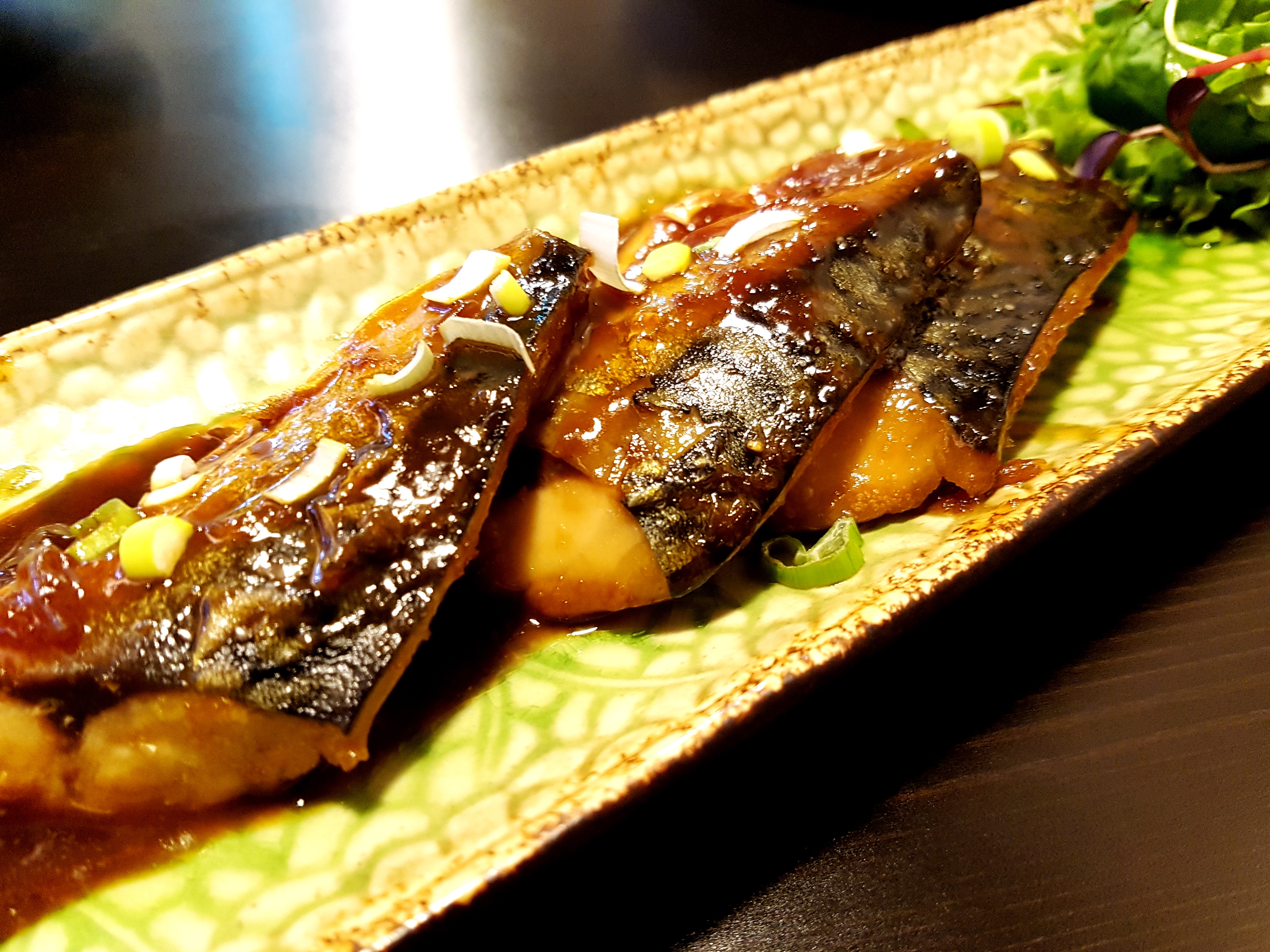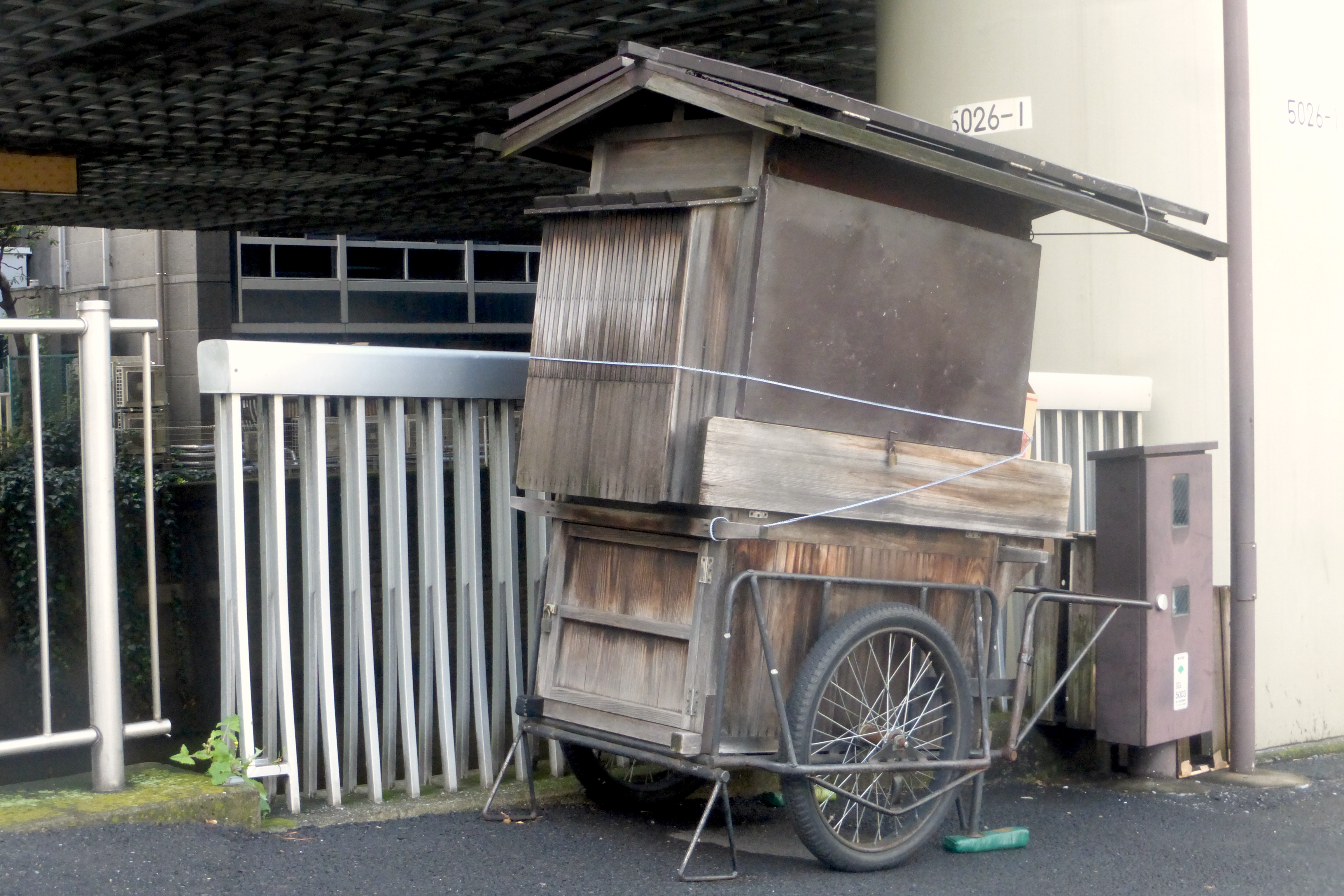|
Oden
is a type of nabemono (Japanese one-pot dishes) consisting of several ingredients such as boiled eggs, daikon or konjac, and processed fishcakes stewed in a light, soy-flavored dashi broth. Oden was originally what is now commonly called ' or simply ''dengaku''; konjac (''konnyaku'') or tofu was boiled and eaten with miso. Later, instead of using miso, ingredients were cooked in dashi, and oden became popular. Ingredients vary according to region and between each household. Karashi is often used as a condiment. Oden is often sold from food carts, though some izakayas and several convenience store chains also serve it, and dedicated oden restaurants exist. Many different varieties are sold, with single-ingredient dishes sometimes as cheap as 100 yen. While it is usually considered a winter food, some carts and restaurants offer oden year-round. Many of these restaurants keep their broth as a master stock, replenishing it as it simmers to let the flavor deepen and ... [...More Info...] [...Related Items...] OR: [Wikipedia] [Google] [Baidu] |
Shizuoka Oden
Shizuoka oden is a variation of ''oden'', a stew-like Cuisine of Japan, Japanese food consisting of fish paste cakes, boiled eggs, ''daikon'', potatoes, kelp rolls, ''konnyaku'', and other ingredients that are first boiled, then kept simmering in a broth until consumption. Overviews Shizuoka oden differs from other types of oden in two ways: the preparation of the broth and the way every ingredient is skewered on a stick. The broth is made with beef sinew (instead of the Katsuobushi, dried skipjack flakes used in other types of oden) and seasoned with strong soy sauce. Because the simmering broth is only replenished rather than discarded, it takes on a very deep, brown-black color, but this process of adding new broth to old is what gives Shizuoka oden a distinctive flavor. Like other types of oden, Shizuoka oden is particularly suitable for consumption in the colder seasons because of its warming effect, much like hot Soup, soups and Stew, stews served in other countries wit ... [...More Info...] [...Related Items...] OR: [Wikipedia] [Google] [Baidu] |
Miso
is a traditional Japanese seasoning. It is a thick paste produced by fermenting soybeans with salt and kōji (the fungus ''Aspergillus oryzae''), and sometimes rice, barley, seaweed, or other ingredients. It is used for sauces and spreads; pickling vegetables, fish, or meats; and mixing with dashi soup stock to serve as miso soup, a Japanese culinary staple food. Miso is high in protein and rich in minerals, and it played an important nutritional role in feudal Japan. Miso is widely used in both traditional and modern cooking in Japan, and as of 2018 had been gaining worldwide interest. Typically, miso is salty, but its flavor and aroma depend on the ingredients and fermentation process. Different varieties of miso have been variously described as salty, sweet, earthy, fruity, or savory. History The origin of miso of Japan is not completely clear. *Grain and fish misos had been manufactured in Japan since the Neolithic era (Jōmon period, 14,000–300 BC). These are ca ... [...More Info...] [...Related Items...] OR: [Wikipedia] [Google] [Baidu] |
Master Stock
A master stock or master sauce () is a Stock (food), stock which is repeatedly reused to Poaching (cooking), poach or Braising, braise meats. It has its origins in Teochew cuisine and is typically used in Cantonese cuisine, Cantonese and Fujian cuisine, Fujian cuisines. Foods poached or braised in the master stock are generally referred to as ''lou mei''. Composition Master stocks are typically begun by simmering meat and bones with typical Chinese ingredients, namely water, soy sauce, Rock candy, rock sugar, Shaoxing wine, Shaoxing or rice wine. Other commonly added spices and flavourings include scallions, shallots, star anise, dried citrus peel, cassia bark, sand ginger, Sichuan pepper, garlic, ginger, and dried Edible mushroom, mushrooms. The Teochew version does not include soy sauce. Use Once the base stock has been prepared, it is then used as a poaching or braising liquid for meat. Chicken as food, Chicken is the most common meat that is cooked in a master stock, although ... [...More Info...] [...Related Items...] OR: [Wikipedia] [Google] [Baidu] |
Miso
is a traditional Japanese seasoning. It is a thick paste produced by fermenting soybeans with salt and kōji (the fungus ''Aspergillus oryzae''), and sometimes rice, barley, seaweed, or other ingredients. It is used for sauces and spreads; pickling vegetables, fish, or meats; and mixing with dashi soup stock to serve as miso soup, a Japanese culinary staple food. Miso is high in protein and rich in minerals, and it played an important nutritional role in feudal Japan. Miso is widely used in both traditional and modern cooking in Japan, and as of 2018 had been gaining worldwide interest. Typically, miso is salty, but its flavor and aroma depend on the ingredients and fermentation process. Different varieties of miso have been variously described as salty, sweet, earthy, fruity, or savory. History The origin of miso of Japan is not completely clear. *Grain and fish misos had been manufactured in Japan since the Neolithic era (Jōmon period, 14,000–300 BC). These are ca ... [...More Info...] [...Related Items...] OR: [Wikipedia] [Google] [Baidu] |
Daikon
Daikon 大根 (だいこん) or mooli, (مولی) ''Raphanus sativus'' var. ''longipinnatus,'' is a mild-flavored winter radish usually characterized by fast-growing leaves and a long, white, root. Originally native to continental East Asia, daikon is harvested and consumed throughout the region, as well as in South Asia, and is available internationally. In some locations, daikon is planted for its ability to break up compacted soils and recover nutrients and is not harvested. Names In culinary contexts, ''daikon'' () or are the most common names in all forms of English. Historical ties to South Asia permit ''mooli'' () as a general synonym in English. The generic terms white radish, winter radish, Oriental radish, long white radish, and other terms are also used. Other synonyms usually vary by region or describe regional varieties of the vegetable. When it is necessary to distinguish the usual Japanese form from others, it is sometimes known as Japanese radish.Rober ... [...More Info...] [...Related Items...] OR: [Wikipedia] [Google] [Baidu] |
Fishcake
A fishcake (sometimes written as fish cake) is a culinary dish consisting of filleted fish or other seafood minced or ground, mixed with a starchy ingredient, and fried until golden. Asian-style fishcakes usually contain fish with salt, water, starch, and egg. They can include a combination of fish paste and surimi. European-style fishcakes are similar to a croquette, consisting of filleted fish or other seafood with potato patty, sometimes coated in breadcrumbs or Batter (cooking), batter. Fishcakes as defined in the ''Oxford Dictionary of Food and Nutrition'' are chopped or minced fish mixed with potato, egg and flour with seasonings of onions, peppers and sometimes herbs. The fishcake has been seen as a way of using up leftovers that might otherwise be thrown away. In Mrs Beeton's 19th century publication ''Mrs Beeton's Book of Household Management, Book of Household Management'', her recipe for fishcakes calls for "leftover fish" and "cold potatoes". More modern recipes have ... [...More Info...] [...Related Items...] OR: [Wikipedia] [Google] [Baidu] |
Kansai
The or the lies in the southern-central region of Japan's main island Honshū. The region includes the prefectures of Nara, Wakayama, Kyoto, Osaka, Hyōgo and Shiga, often also Mie, sometimes Fukui, Tokushima and Tottori. The metropolitan region of Osaka, Kobe and Kyoto (Keihanshin region) is the second-most populated in Japan after the Greater Tokyo Area. Name The terms , , and have their roots during the Asuka period. When the old provinces of Japan were established, several provinces in the area around the then-capital Yamato Province were collectively named Kinai and Kinki, both roughly meaning "the neighbourhood of the capital". Kansai (literally ''west of the tollgate'') in its original usage refers to the land west of the Osaka Tollgate (), the border between Yamashiro Province and Ōmi Province (present-day Kyoto and Shiga prefectures).Entry for . Kōjien, fifth edition, 1998, During the Kamakura period, this border was redefined to include Ōmi and I ... [...More Info...] [...Related Items...] OR: [Wikipedia] [Google] [Baidu] |
Nagoya
is the largest city in the Chūbu region of Japan. It is the list of cities in Japan, fourth-most populous city in Japan, with a population of 2.3million in 2020, and the principal city of the Chūkyō metropolitan area, which is the List of metropolitan areas in Japan, third-most populous metropolitan area in Japan with a population of 10.11million. Located on the Pacific Ocean, Pacific coast in central Honshu, it is the capital and most populous city of Aichi Prefecture, with the Port of Nagoya being Japan's largest seaport. In 1610, the warlord Tokugawa Ieyasu, a retainer of Oda Nobunaga, moved the capital of Owari Province from Kiyosu to Nagoya. This period saw the renovation of Nagoya Castle. The arrival of the 20th century brought a convergence of economic factors that fueled rapid growth in Nagoya during the Meiji Restoration, and it became a major industrial hub for Japan. The traditional manufactures of timepieces, bicycles, and sewing machines were followed by the p ... [...More Info...] [...Related Items...] OR: [Wikipedia] [Google] [Baidu] |
Tofu
or bean curd is a food prepared by Coagulation (milk), coagulating soy milk and then pressing the resulting curds into solid white blocks of varying softness: ''silken'', ''soft'', ''firm'', and ''extra (or super) firm''. It originated in China and has been consumed in the country for over 2,000 years. Tofu is a traditional component of many East Asian cuisine, East Asian and Southeast Asian cuisine, Southeast Asian cuisines; in modern Western cooking, it is often used as a Meat alternative, meat substitute. Nutritionally, tofu is low in calories, while containing a relatively large amount of protein. It is a high and reliable source of iron, and can have a high calcium or magnesium content depending on the Flocculation, coagulants (e.g. calcium chloride, calcium sulphate, magnesium sulphate) used in manufacturing. Cultivation of tofu, as a protein-rich food source, has one of the lowest needs for land use (1.3 m²/ 1000 kcal) and emits some of the lowest amount of greenhouse ... [...More Info...] [...Related Items...] OR: [Wikipedia] [Google] [Baidu] |
Yatai (retail)
A is a small, mobile food stall in Japan typically selling ramen or other food. The name literally means "shop stand". The stall is set up in the early evening on walkways and removed late at night or in the early morning hours. Though the practice of mobile food stands dates back to the 17th century, ''yatai'' became popular and widespread in the Meiji period (1868–1912) and were two-wheeled pushcarts constructed of wood. ''Yatai'' were popular during and following World War II, but Japanese authorities imposed regulations ahead of the 1964 Tokyo Olympics, citing health concerns. Today, they are prevalent in Fukuoka, but continue to dwindle. Carts ''Yatai'' are typically wooden carts on wheels, equipped with kitchen appliances and seating. Handles and seating fold into the cart while it is being transported. A pushcart usually measures 3 by 2.5 meters. Vendors serve a variety of foods such as ramen, gyoza, and tempura. Beer, ''sake'', and '' shōchū'' are usually avail ... [...More Info...] [...Related Items...] OR: [Wikipedia] [Google] [Baidu] |
Izakaya
An () is a type of informal Japanese Bar (establishment), bar that serves alcoholic drinks and snacks. are casual places for after-work drinking, similar to a pub, a Spanish tapas bar, or an American saloon or tavern. Etymology The word entered the English language by 1987. It is a compound word consisting of ("to stay") and ("sake shop"), indicating that originated from sake shops that allowed customers to sit on the premises to drink. are sometimes called ('red lantern') in daily conversation, as such paper lanterns are traditionally found in front of them. History Anecdotes and songs that appear in the show that -style establishments existed in Japan at the early 700s. There is a record dating to 733 when rice was collected as a brewing fee tax under the jurisdiction of the government office called . In the , written in 797, there is a record of :ja:葦原王, King Ashihara who got drunk and was murdered in a tavern in 761. The full-scale development of bega ... [...More Info...] [...Related Items...] OR: [Wikipedia] [Google] [Baidu] |
Convenience Store
A convenience store, convenience shop, bakkal, bodega, corner store, corner shop, superette or mini-mart is a small retail store that stocks a range of everyday items such as convenience food, groceries, beverages, tobacco products, lottery tickets, over-the-counter drugs, toiletries, newspapers and magazines. In some jurisdictions, convenience stores (such as off-licences in the UK) are licensed to sell alcoholic drinks, although many other jurisdictions limit such beverages to those with relatively low alcohol content, like beer and wine. The stores may also offer money order and wire transfer services, along with the use of a fax machine or photocopier for a small per-copy cost. Some also sell tickets or recharge smart cards, e.g. Opus cards in Montreal, Canada, or include a small deli. They differ from general stores and village shops in that they are not in a rural location and are used as a convenient (hence their common name) supplement to larger stores. A con ... [...More Info...] [...Related Items...] OR: [Wikipedia] [Google] [Baidu] |









